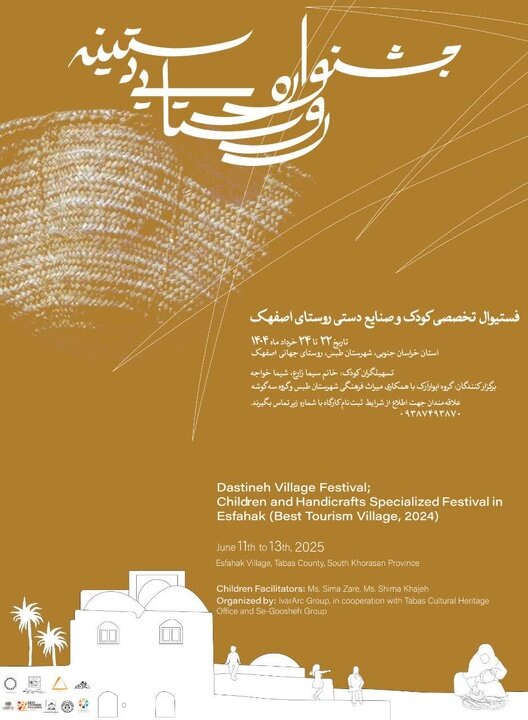According to the head of Tabas’ Cultural Heritage, Tourism and Handicrafts Bureau, Tehran – recently recognized as one of the world’s best tourist villages by UN tourism, Esfahak is set to hold a special rural festival from June 12th to 14th.
According to Miras Arya (CHTN), Mohammad Arab is dedicated to children aged 5 to 8 years old and aims to provide unique insight into rural life in this acclaimed desert village, with the aim of celebrating local culture, traditions and crafts.
The event will be held in collaboration with Tabas’ Cultural Heritage, Tourism and Handicrafts Bureau, Ivararc Group and the 3-Goosheh group, officials added.
He also said the three-day event aims to accustom the cultural heritage and handicrafts of Esfahak village, promote creative skills, get to know the local culture and enhance tourism and culture sense in an interesting and scientific environment.
Parts of the Arabs train the concept of cultural heritage and handicrafts in simple language, promote children’s movements and artistic abilities in various fields, promote local games and traditional music, strengthen a sense of belonging and respect for culture, create artistic items such as paintings, ceramics, local dolls, local dolls, rural tourism, learn about the landscapes that showcase the village, and introduce the village. Childish language, water play, free outdoor games handicrafts. He added that the attendance certificate will be issued to participants at the end of the course.
The Arabs have mentioned promoting culture and art among the younger generations, creating a sense of confidence and creativity for children, and developing effective connections between cultural heritage and children’s communities as one of the benefits and long-term goals of this project, which is being held continuously in this beautiful village.
He also tries to attract families, develop cultural tourism in the village, tell attractive places, homes, traditional uses, local stories, introduce simple handicrafts, create things that have been engraved in children’s minds, draw pictures of village landscapes and handicrafts, create village paintings and village paintings, group games, simple simple shapes for making threads for sewing weaving, and try to photograph waste separation and environmental culture, exhibitions of created works, and public visits to the exhibitions, are other programs planned.
He recalled that Esfahak was introduced and registered in November 2024 as the second best tourist village of UN Tourist Village.
“We plan to turn this beautiful village into a base for science tourists by implementing a science and training program.”
The village of Esfahak in South Holasan Province has been awarded one of UNESCO’s 34 prestigious research chairs, marking the achievements of the local and national cultural heritage and scientific community.
The announcement was made by the Arabs in May 2025 and confirmed that Esfahak had secured a seat on the UNESCO Research Committee.
This distinction was granted in recognition of the village’s innovative work in global architecture and scientific contributions through the Esfahak Mud Center (EMC), led by architect and researcher Pouya Khazaeli.
One of the best tourist villages in UN tourism, Esfahak has attracted international attention for its sustainable reconstruction and architectural preservation efforts. The Global Awareness nomination document included extensive scientific research conducted by the EMC and played an important role in winning UNESCO research seats.
“The award of this chair is not only a great honor for Esfahak and his people, but also highlights the scientific and cultural potential of the village at a global stage,” the Arab said. “It reflects the dedication of the local community, especially the youth, and will help us to showcase Esfahak’s achievements to more professional tourism audiences and researchers around the world.”
UNESCO Research Chair promotes higher education and collaborative knowledge production around the world in areas such as education, science and culture. Each chair is established within the university or research institution for a renewable four-year term of office and must include prominent academic leaders, researchers, faculty and students who will work with them in their specialties.
The Arabs emphasized that Esfahak’s chairs will focus on sustainable and traditional architectural practices, aiming to function as a model for similar communities around the world, enhancing academic cooperation, knowledge sharing and cultural tourism.
Last year, Esfahak was named one of the best tourist villages by United Nations Tourism in 2024. Additionally, the village won the To Do Award in 2020. The award is announced annually by the German Institute of Tourism Development.
Esfahak, severely damaged by the 1978 earthquake that hit Tabas, was once considered uninhabitable and its residents lived in temporary tents. Later, when they began rebuilding their lives they built a makeshift wooden room known as the Otug e Chobi (wooden room).
Due to their commitment to sustainability and cultural conservation, villagers have reestablished the community over the years, developing eco-lodges and restoring traditional homes using ancient Adobe techniques.
Esfahak’s transformation into a cultural and ecotourism destination attracted attention for its unique architecture and sustainable practices, winning the village’s prestigious Asian Architecture Award. Today, it attracts tourists from all over the world and is drawn to its picturesque Adobe structure and commitment to maintaining its local identity.
Since 2021, the best Tourism Village Initiative aims to promote sustainable tourism in rural areas and focuses on preserving the natural landscape, cultural heritage, and indigenous lifestyles, including gastronomy and local values.
KD

